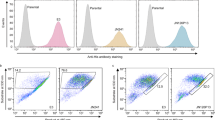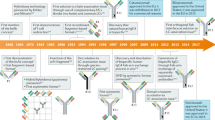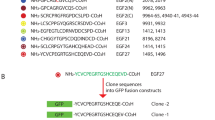Abstract
Many ligands have been described that interact with specific receptors on cells, with subsequent effects on cellular physiology. Recent advances in immunology and molecular biology have greatly enhanced our understanding of how ligands and receptors interact. The development of both polyclonal and monoclonal antireceptor antibodies has allowed the isolation and subsequent characterization of a wide variety of receptor structures. Molecular cloning techniques have allowed the elucidation of the primary amino acid sequences of many receptors and their cognate ligands. Here we describe a method for the development of receptor binding peptides based on the primary structure of antireceptor antibodies.
This is a preview of subscription content, access via your institution
Access options
Subscribe to this journal
Receive 12 print issues and online access
$209.00 per year
only $17.42 per issue
Buy this article
- Purchase on Springer Link
- Instant access to full article PDF
Prices may be subject to local taxes which are calculated during checkout
Similar content being viewed by others
References
Kilham, L. and Margolis, G. 1969. Hydrocephalus in hamsters, ferrets, rats and mice following inoculations with reovirus type 1. I. Virologic studies. Lab. Invest. 21:183–188.
Raine, C.S. and Fields, B.N. 1973. Reovirus type 3 encephalitis—a virologic and ultrastructural study. J. Neuropathol. Exp. Neurol. 32:19–33.
Weiner, H.L., Powers, M.L. and Fields, B.N. 1980. Absolute linkage of virulence and central nervous system cell tropism of reoviruses to viral hemagglutinin. J. Infect. Dis. 141:609–619.
Epstein, R.L., Powers, M.L., Rogart, R.B. and Weiner, H.L. 1984. Binding of 125I-labeled reovirus to cells with surface receptors. Virology 133:46–55.
Yeung, M.C., Gill, M.J., Alibhai, S.S., Shahrabadi, M.S., and Lee, P.W.K. 1987. Purification and characterization of the reovirus cell attachment protein σ1. Virology 156:377–385.
Weiner, H.L., Powers, M.L. and Fields, B.N. 1980. Absolute linkage of virulence and central nervous system cell tropism of reoviruses to viral hemagglutinin. J. Infect. Dis. 141:609–619.
Weiner, H.L., Drayna, D., Averill, D.R. Jr. and Fields, B.N. 1977. Molecular basis of reovirus virulence: Role of the S1 gene. Proc. Natl. Acad. Sci. USA 74:5744–5748.
Kaye, K.M., Spriggs, D.R., Bassel-Duby, R., Fields, B.N., and Tyler, K.L. 1986. Genetic basis for altered pathogenesis of an immune selected antigenic variant of reovirus type 3 (Dearing). J. Virol 59:90–97.
Jerne, N.K. 1974. Toward a network theory of the immune system. Ann. de Immunol. 125:373–389.
Nepom, J.T., Weiner, H.L., Dichter, M.A., Tardieu, M., Spriggs, D.R., Gentsch, J., Fields, B.N. and Greene, M.I. 1982. Identification of a hemagglutinin-specific idiotype associated with reovirus recognition shared by lymphoid and neural cells. J. Exp. Med. 155:155–167.
Nepom, J.T., Tardieu, M., Epstein, R.L., Noseworthy, J.H., Weiner, H.L., Gentsch, J. and Greene, M.I. 1982. Virus binding receptors. Similarities to immune receptors as determined by anti-idiotypic antibodies. Surv. Immunol. Res. 1:255–261.
Gaulton, G.N., Co, M.S., Royer, H.-D., and Greene, M.I. 1985. Anti-idiotypic antibodies as probes of cell surface receptors. Mol. Cell. Biochem. 65:5–21.
Co, M.S., Gaulton, G.N., Fields, B.N. and Greene, M.I. 1985. Isolation and biochemical characterization of the mammalian reovirus type 3 cell-surface receptor. Proc. Natl. Acad. Sci. USA. 82:1494–1498.
Liu, J., Co, M.S. and Greene, M.I. 1989. Reovirus type 3 and (I125) iodocyanopindolol bind distinct domains of the reovirus receptor. Immunol. Res. In Press.
Noseworthy, J.H., Fields, B.N., Dichter, M.A., Sobotka, C., Pizer, E., Perry, L.L., Nepom, J.T., and Greene, M.I. 1983. Cell receptors for the mammalian reovirus. I. Syngeneic monoclonal anti-idiotypic anti-body identifies a cell surface receptor for reovirus. J. Immunol. 131:2533–2538.
Kauffman, R.S., Noseworthy, J.H., Nepom, J.T., Finberg, R., Fields, B.N. and Greene, M.I. 1983. Cell receptors for mammalian reovirus. II. Monoclonal anti-idiotypic antibody blocks viral binding to cells. J. Immunol. 131:2539–2541.
Gaulton, G.N., Co, M.S. and Greene, M.I. 1985. Anti-idiotypic antibody identifies the cellular receptor of reovirus type 3. J. Cell. Biochem. 28:69–78.
Bruck, C., Co, M.S., Slaoui, M., Gaulton, G.N., Smith, T., Fields, B.N., Mullins, J.I., and Greene, M.I. 1986. Nucleic acid sequence of an internal image-bearing monoclonal anti-idiotype and its comparison to the sequence of the external antigen. Proc. Natl. Acad. Sci. USA 83:6578–6582.
Chou, P.Y. and Fasman, G.D. 1974. Prediction of protein conformation. Biochemistry 13:222–245.
Williams, W.V., Guy, H.R., Rubin, D.H., Robey, F., Myers, J.N., Kieber-Emmons, T., Weiner, D.B. and Greene, M.I. 1988. Sequences of the cell-attachment sites of reovirus type 3 and its anti-idiotypic/antireceptor antibody: Modeling of their three-dimensional structures. Proc. Natl. Acad. Sci. USA 85:6488–6492.
Williams, W.V., Guy, H.R., Weiner, D., Rubin, D. and Greene, M.I. 1988. Structure of the neutralizing epitope of the reovirus type 3 hemagglutin, p 25–28. In: Vaccines 88 H. Ginsberg, F. Brown, R. A. Lerner, and R. M. Chanock (Eds.). Cold Spring Harbor Press New York.
Williams, W.V., Moss, D.A., Cohen, J.A., Myers, J.N., Weiner, D.B. and Greene, M.I. 1989. Development of biologically active peptides based on antibody structure. Manuscript submitted.
Taub, R., Gould, R.J., Garsky, V.M., Ciccarone, T.M., Hoxie, J., Friedman, P.A. and Shattil, S.J. 1987. A monoclonal antibody against the platelet fibrinogen receptor contains a sequence that mimics the receptor recognition domain in fibrinogen. J. Biol. Chem. In Press.
Author information
Authors and Affiliations
Rights and permissions
About this article
Cite this article
Williams, W., Weiner, D., Cohen, J. et al. Development and Use of Receptor Binding Peptides Derived From Antireceptor Antibodies. Nat Biotechnol 7, 471–475 (1989). https://doi.org/10.1038/nbt0589-471
Issue Date:
DOI: https://doi.org/10.1038/nbt0589-471



